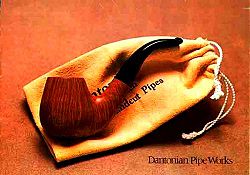Knudsen, Sven
Sven Knudsen, elder brother of Teddy Knudsen, is without any doubt one of the most important and influential characters of the early Danish freehand pipemakers.
Poul Rasmussen, who himself was hardly more than an apprentice at that time and still being instructed in pipemaking by Sixten Ivarsson, who for his part was about to leave and join Poul Nielsen (→ Stanwell), picked him up and introduced him to the famous Suhr's Pibemageri (pipe workshop) in 1956. Sven Knudsen, as all the others too, started with repairing pipes. But revealing enormous talent and dedicative diligence, he soon proceeded to make complete pipes on his own. And all too soon a considerable share of responsibility for the workshop pressed on his shoulders, because Poul Rasmussen was not only an exceptionally gifted pipemaker but also a very worldly and gregarious man, who left the workbench often enough to join some jovial company for a nice chat and a glass of beer. So Sven Knudsen ended up designing many of the shapes and carving many of the pipes subsequently identified with and credited to Rasmussen. At Suhr's, he hired and trained Hans Jonny Nielsen, who became famous under his nickname Former lateron.
In 1959 he had enough of this unfavourable situation and left Rasmussen. Sven Knudsen furnished a small workshop of his own in Copenhagen and began to work as self-employed pipemaker. He sold his pipes to some of the most prestigious Copenhagen P&T shops like W.Ø. Larsen, Poul Olsen (of "My Own Blend" fame) and Pibe-Dan. The house catalogs featured his pipes prominently for many years. From the Pibe-Dan catalog 1961/1962:
Furthermore he was contacted by Svend Bang, Ole Larsen's right-hand man, who offered him the position as workshop manager at the newly established W.Ø. Larsen workshop. BTW, Ole Larsen, the proprietor, and Sven Knudsen became very close friends. Under the aegis of Sven Knudsen W.Ø. Larsen pipes became one of the bedrocks of the Danish freehand fame!
Four years later, in 1963, he decidided to move to the countryside. So he closed his Copenhagen workshop and resigned from Larsen after he had urgently ensured that Former Nielsen succeeded him as workshop manager at W.Ø. Larsen. In Tappernoje, a hamlet belonging to the small town of Præstoe on the Island of Fyn, he bought a house and established an all-new workshop. There he lived from 1963 - 1973.

In 1970 Teddy Knudsen had taken leave from Anne Julie tired of making highgrade pipes but being paid as gofer. His elder brother, invited him to join together at Sven's place in Tappernoje. They agreed to work together and started a project they called "Dantonian PipeWorks". They selected a compilation of pipes and in early 1971 they published the Dantonian PipeWorks Catalog worldwide. In English only, because the brothers orientated to the export markets in Germany, the United States, and particularly in Japan. The pipes were made to order both for customers and retailers.
The catalog portrayed a carefully balanced selection of models. Some Sven had developed and refined earlier when he was at Suhr's Pibemageri and later when working for W.Ø. Larsen and Pibe-Dan. Shapes like the "Walrus" or the "Swan" had already earned him a considerable reputation, and yet others that were newly sketched now. Teddy also added some of his own designs.
The pipes, stamped "Dantonian - Handicraft of Copenhagen", became very popular and a considerable success in sale. But even though the fraternal company broke apart after ca. 2½ years. Teddy left in early 1973 to pursue his own way. Sven Knudsen moved to Næstved where he continued to make pipes under the Dantonian name for some years more.
Sixten Ivarsson, who cherished Sven's work very much, introduced Sven's pipes to his Japanese customers. No wonder-- thanks to Sixten's personal recommendation and due to their outstanding quality Sven's pipes became very popular in Japan quickly.
Under construction!


